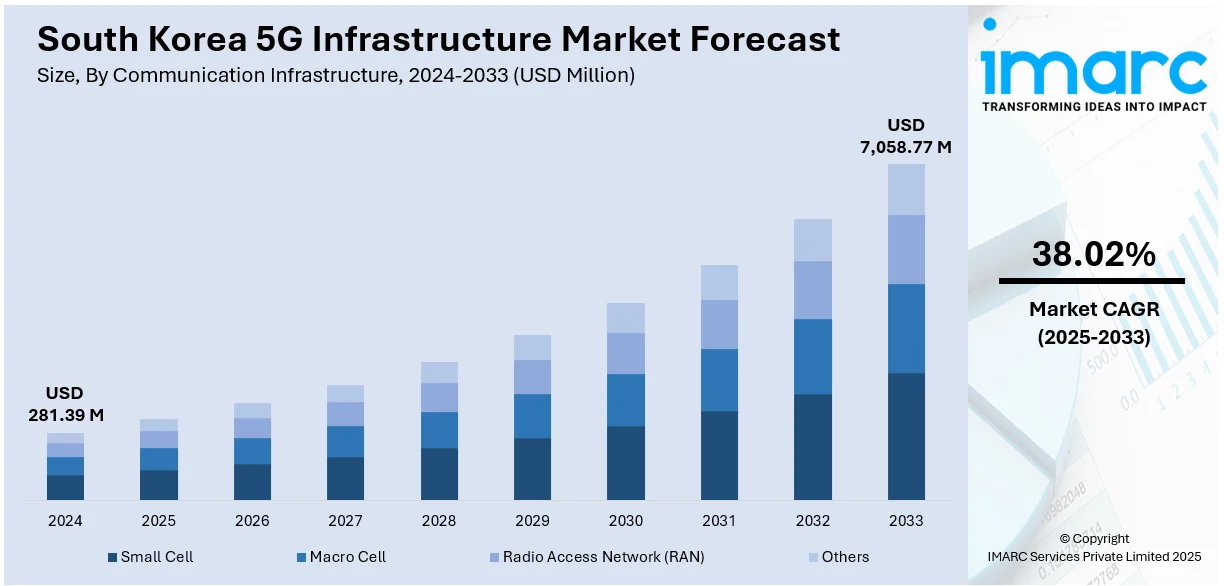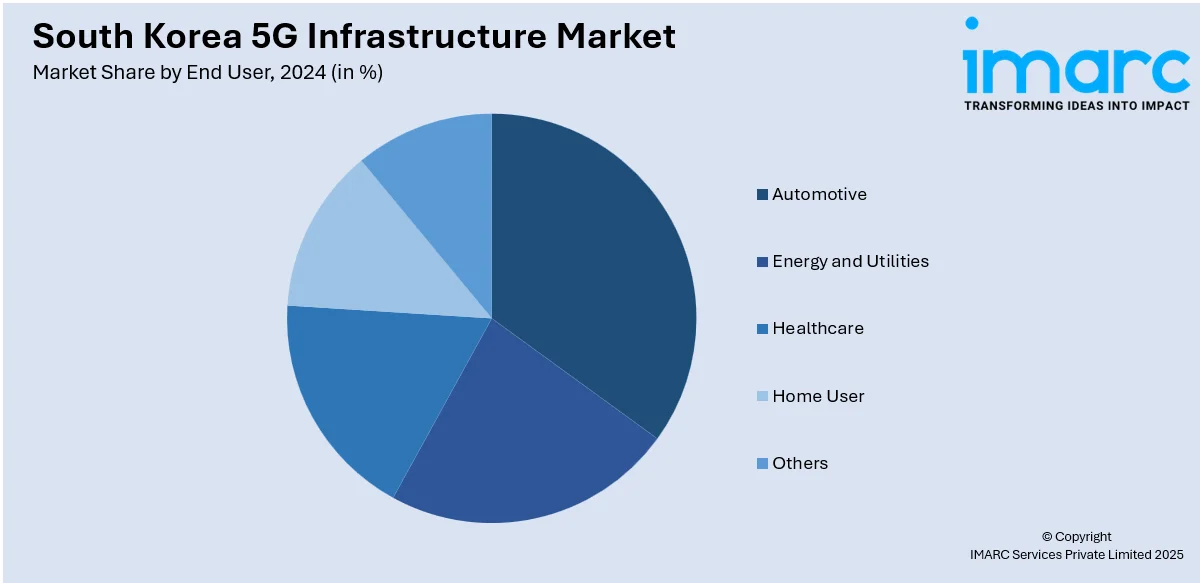
South Korea 5G Infrastructure Market Size, Share, Trends and Forecast by Communication Infrastructure, Network Technology, Network Architecture, Frequency, End User, and Region, 2025-2033
South Korea 5G Infrastructure Market Overview:
The South Korea 5G infrastructure market size reached USD 281.39 Million in 2024. The market is projected to reach USD 7,058.77 Million by 2033, exhibiting a growth rate (CAGR) of 38.02% during 2025-2033. Increased investments in 5G infrastructure by the public and private sectors are accelerating the deployment of high-speed, low-latency networks across the country. Besides this, as more industries, homes, and cities are integrating connected devices, ranging from smart appliances to industrial sensors, the need for a robust communication network is becoming essential, fueling the South Korea 5G infrastructure market share.
|
Report Attribute
|
Key Statistics
|
|---|---|
|
Base Year
|
2024
|
|
Forecast Years
|
2025-2033
|
|
Historical Years
|
2019-2024
|
| Market Size in 2024 | USD 281.39 Million |
| Market Forecast in 2033 | USD 7,058.77 Million |
| Market Growth Rate 2025-2033 | 38.02% |
South Korea 5G Infrastructure Market Trends:
Rising expenditure on 5G infrastructure development
Increased investments in 5G infrastructure by the public and private sectors are accelerating the deployment of high-speed, low-latency networks in South Korea. The government is actively supporting 5G development through funding, regulatory support, and strategic partnerships aimed at maintaining South Korea’s position as a worldwide leader in telecommunications. As per industry reports, South Korea's 5G network exhibited a 9.2% increase in speed in 2024. Private telecom companies and technology firms are wagering on building advanced base stations, fiber-optic networks, and related infrastructure to ensure seamless connectivity and expand coverage. These investments are facilitating the rollout of next-generation services, such as smart cities, autonomous vehicles, telemedicine, and industrial automation. Enhanced 5G infrastructure also enables the widespread adoption of cloud computing services, creating new opportunities for innovations and efficiency. Public-private collaboration is leading to faster implementation timelines, improved service quality, and greater network resilience. Additionally, the integration of 5G with artificial intelligence (AI), augmented reality, and edge computing is transforming user experiences across sectors. This robust investment climate is not only fueling technological advancements but also boosting job creation, stimulating economic activity, and attracting global partnerships. As the demand for high-performance connectivity continues to grow, the ongoing expenditure ensures that South Korea’s 5G infrastructure is evolving rapidly to meet the needs of a digitally driven society.

To get more information on this market, Request Sample
Increasing utilization of Internet of Things (IoT)
Rising IoT adoption is propelling the South Korea 5G infrastructure market growth. According to industry reports, the South Korea IoT sector expanded by almost 2 Trillion Won (USD 1.45 Billion) in 2024. As more industries, homes, and cities are integrating connected devices, ranging from smart appliances and wearable health monitors to industrial sensors and autonomous systems, the need for a robust communication network is becoming essential. 5G infrastructure supports the high device density and real-time data exchange that IoT applications require. In South Korea, where smart city development, digital healthcare, and intelligent transportation systems are rapidly broadening, 5G plays a critical role in ensuring seamless and efficient IoT operations. The ultra-reliable and low-latency nature of 5G enables uninterrupted machine-to-machine communication, remote monitoring, and automation across various sectors. Telecom companies and tech firms continue to invest in expanding 5G coverage to support this interconnected ecosystem. As IoT devices are becoming more embedded in daily life and business operations, the need to strengthen 5G infrastructure is growing.
South Korea 5G Infrastructure Market Segmentation:
IMARC Group provides an analysis of the key trends in each segment of the market, along with forecasts at the country and regional levels for 2025-2033. Our report has categorized the market based on communication infrastructure, network technology, network architecture, frequency, and end user.
Communication Infrastructure Insights:
- Small Cell
- Macro Cell
- Radio Access Network (RAN)
- Others
The report has provided a detailed breakup and analysis of the market based on the communication infrastructure. This includes small cell, macro cell, radio access network (RAN), and others.
Network Technology Insights:
- Software-Defined Networking
- Network Function Virtualization
- Others
A detailed breakup and analysis of the market based on the network technology have also been provided in the report. This includes software-defined networking, network function virtualization, and others.
Network Architecture Insights:
- Standalone
- Non-Standalone
The report has provided a detailed breakup and analysis of the market based on the network architecture. this includes standalone and non-standalone.
Frequency Insights:
- Sub-6 Ghz
- Above 6 Ghz
A detailed breakup and analysis of the market based on the frequency have also been provided in the report. This includes sub-6 Ghz and above 6 Ghz.
End User Insights:

- Automotive
- Energy and Utilities
- Healthcare
- Home User
- Others
The report has provided a detailed breakup and analysis of the market based on the end user. This includes automotive, energy and utilities, healthcare, home user, and others.
Regional Insights:
- Seoul Capital Area
- Yeongnam (Southeastern Region)
- Honam (Southwestern Region)
- Hoseo (Central Region)
- Others
The report has also provided a comprehensive analysis of all the major regional markets, which include Seoul Capital Area, Yeongnam (Southeastern Region), Honam (Southwestern Region), Hoseo (Central Region), and others.
Competitive Landscape:
The market research report has also provided a comprehensive analysis of the competitive landscape. Competitive analysis such as market structure, key player positioning, top winning strategies, competitive dashboard, and company evaluation quadrant has been covered in the report. Also, detailed profiles of all major companies have been provided.
South Korea 5G Infrastructure Market News:
- In February 2025, HFR Mobile, a private 5G and DX solution provider in South Korea, introduced a public safety solution based on private 5G for municipal authorities. FR Mobile set up a 5G core and base station (CU/DU) at the Integrated Control Center, a facility for public safety in Gimcheon City. The company installed a radio unit (RU) at Ansan Park in Gimcheon Innovation City to establish an extensive private 5G infrastructure utilizing the city's own self-communication network.
- In October 2024, Samsung Electronics and KT Corporation (KT) announced that they were chosen to implement a private 5G network for the Republic of Korea (ROK) Navy's 'Smart Naval Port' initiative. Private 5G solutions were crucial for national defense sectors, as they demanded ultra-fast speeds and highly connected communications to ensure reliable and efficient operational management. The firms would develop a smarter and completely autonomous network infrastructure to ensure uninterrupted coverage and improved connectivity for the Republic of Korea Navy 2nd fleet.
South Korea 5G Infrastructure Market Report Coverage:
| Report Features | Details |
|---|---|
| Base Year of the Analysis | 2024 |
| Historical Period | 2019-2024 |
| Forecast Period | 2025-2033 |
| Units | Million USD |
| Scope of the Report | Exploration of Historical Trends and Market Outlook, Industry Catalysts and Challenges, Segment-Wise Historical and Future Market Assessment:
|
| Communication Infrastructures Covered | Small Cell, Macro Cell, Radio Access Network (RAN), Others |
| Network Technologies Covered | Software-Defined Networking, Network Function Virtualization, Others |
| Network Architectures Covered | Standalone, Non-Standalone |
| Frequencies Covered | Sub-6 Ghz, Above 6 Ghz |
| End Users Covered | Automotive, Energy and Utilities, Healthcare, Home User, Others |
| Regions Covered | Seoul Capital Area, Yeongnam (Southeastern Region), Honam (Southwestern Region), Hoseo (Central Region), Others |
| Customization Scope | 10% Free Customization |
| Post-Sale Analyst Support | 10-12 Weeks |
| Delivery Format | PDF and Excel through Email (We can also provide the editable version of the report in PPT/Word format on special request) |
Key Questions Answered in This Report:
- How has the South Korea 5G infrastructure market performed so far and how will it perform in the coming years?
- What is the breakup of the South Korea 5G infrastructure market on the basis of communication infrastructure?
- What is the breakup of the South Korea 5G infrastructure market on the basis of network technology?
- What is the breakup of the South Korea 5G infrastructure market on the basis of network architecture?
- What is the breakup of the South Korea 5G infrastructure market on the basis of frequency?
- What is the breakup of the South Korea 5G infrastructure market on the basis of end user?
- What is the breakup of the South Korea 5G infrastructure market on the basis of region?
- What are the various stages in the value chain of the South Korea 5G infrastructure market?
- What are the key driving factors and challenges in the South Korea 5G infrastructure market?
- What is the structure of the South Korea 5G infrastructure market and who are the key players?
- What is the degree of competition in the South Korea 5G infrastructure market?
Key Benefits for Stakeholders:
- IMARC’s industry report offers a comprehensive quantitative analysis of various market segments, historical and current market trends, market forecasts, and dynamics of the South Korea 5G infrastructure market from 2019-2033.
- The research report provides the latest information on the market drivers, challenges, and opportunities in the South Korea 5G infrastructure market.
- Porter's five forces analysis assist stakeholders in assessing the impact of new entrants, competitive rivalry, supplier power, buyer power, and the threat of substitution. It helps stakeholders to analyze the level of competition within the South Korea 5G infrastructure industry and its attractiveness.
- Competitive landscape allows stakeholders to understand their competitive environment and provides an insight into the current positions of key players in the market.
Need more help?
- Speak to our experienced analysts for insights on the current market scenarios.
- Include additional segments and countries to customize the report as per your requirement.
- Gain an unparalleled competitive advantage in your domain by understanding how to utilize the report and positively impacting your operations and revenue.
- For further assistance, please connect with our analysts.
 Request Customization
Request Customization
 Speak to an Analyst
Speak to an Analyst
 Request Brochure
Request Brochure
 Inquire Before Buying
Inquire Before Buying




.webp)




.webp)












